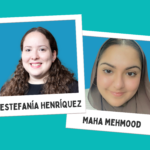
Cara Carter is a second-year Maternal and Child Health (MCH) Master of Public Health (MPH) student at the University of Minnesota-Twin Cities. Her background is in pharmacy, mathematics, and engineering. Cara received her BS in Mathematics from Philander Smith College, BS in Chemical Engineering from the University of Arkansas, and Doctor of Pharmacy from Bill Gatton College of Pharmacy at East Tennessee State University. Cara also has a teaching certificate from the University of Missouri-Kansas City School of Pharmacy. She is currently a pediatric pharmacist in West Virginia. She has a passion for patient advocacy and aspiration to work for the United States Food and Drug Administration (FDA) which is what inspired her to pursue her MPH. During her first year in MCH, she received deployment funding from the Center for Leadership Education in Maternal and Child Public Health to serve as an intern at the Minnesota Perinatal Quality Collaborative (MNPQC), where she assisted with their hypertension initiative and substance use and recovery efforts.
About the Minnesota Perinatal Quality Collaborative
The MNPQC was co-founded by the Minnesota Perinatal Organization (MPO) and the Minnesota Department of Health (MDH) in 2018. Pursuing my deployment with the MNPOC provided me with the opportunity to enhance my skills in Competency 10: Interdisciplinary/Interprofessional Team Building as it brings together providers of various levels and specialties as well as various types of healthcare organizations across the state of Minnesota to provide optimal perinatal healthcare. MNPQC provides education, tool kits, networking, support, and other resources to healthcare organizations around the state to assist providers in increasing their knowledge and skills. Some initiatives at the MNPQC currently include Preterm Birth Prevention, Hypertension in Pregnancy, Mother/Infant Opioid Substance Use Treatment and Recovery Effort (MOSTaRE), and COVID-19 resources.
Significance of Hypertension Initiative
Treatment of hypertensive urgency in pregnancy is considered a best practice but is often a difficult feat to treat on a consistent basis. In Minnesota and nationally, Black and Native American people are disproportionately affected by hypertensive disorders of pregnancy. There are other risk factors for hypertensive disorders including hypertension diagnosis prior to pregnancy, prior preeclampsia, obesity, advanced maternal age, multiple gestations, and Type 1 or Type 2 Diabetes. This initiative is important because hypertensive disorders of pregnancy have a mortality rate of up to 17% in the United States.
The aim of the hypertension initiative is to “develop reliable processes of recognition and treatment of obstetric hypertension during pregnancy and up to six weeks postpartum to reduce severe pregnancy and up to six weeks postpartum to reduce severe maternal morbidity by 25% and achieve 80% or higher compliance of the hypertension recognition tool and obstetric hypertension emergency pathway.”
The aim is to reach this goal by February of 2023; in order to reach this goal, a toolkit was created to provide to partner healthcare organizations to assist them in their efforts.
Working with the Hypertensive Initiative
While deployed to the MNPQC, I took part in working in the Hypertension Initiative. Since the initiative is an ongoing effort and requires data collection, one of my roles was creating the data collection tool. I evaluated the desired outcomes and assisted the faculty group in developing a survey that collects targeted data to evaluate the effect of this effort.This initiative also includes an Emergency Room (ER) poster and ER treatment algorithm. Due to my clinical background in pharmacy, I was able to review the clinical information in these tools for correct medication information.
Reflecting on my Experience with an Interdisciplinary Team
This experience was groundbreaking for me. While I learned about hypertension in pregnancy, including hypertensive urgency and hypertensive emergency, in both pharmacy school and residency, this was the first time I was able to apply this information in a preventative manner to public health at large versus the care of an individual patient. In my career, I regularly treat birthing and pregnant individuals in hypertensive urgency and hypertensive emergency. I also treat the newborn babies of women who have these conditions and who have been treated for these conditions during the labor and delivery process. It was a very unique experience to be working on a multidisciplinary team to prevent the need for these treatments in the mother and child. The tools created in this experience are something I plan to share with my colleagues as I continue to progress in my field.
COVID-19 Vaccine Hesitancy
After the emergence of the COVID-19 virus, a vaccine for COVID-19 soon followed. Like with many vaccines, this brought about conversations related to vaccine hesitancy especially in pregnant individuals who were not included in the vaccine’s clinical trials. While many organizations including the American College of Obstetricians and Gynecologists (ACOG), Society of Maternal-Fetal Medicine (SMFM), and the Centers for Disease Control and Prevention (CDC) recommend that pregnant individuals, not all members of this population are at ease receiving the vaccine. This also provides challenges for healthcare providers when encouraging their patients to become vaccinated.
How My Interdisciplinary/Interprofessional Experience Continues in my Work
Through my deployment at the MNPQC, I have been afforded the opportunity to work within my personal area of interest: vaccine hesitancy. MNPQC has allowed me to provide education for healthcare providers surrounding vaccine hesitancy and specifically COVID-19 vaccine hesitancy in pregnant individuals. I have authored Twitter messages that highlight recommendations from ACOG, SMFM, and the CDC regarding the COVID-19 vaccine in pregnant individuals. I have also written a newsletter article geared toward healthcare providers to educate them on vaccine hesitancy and ways to combat it.
Through this experience, I learned how to use social media as a tool to educate the community. Prior to this, I did not have much experience using social media in a professional setting. It was eye-opening to see how something I use daily, such as social media, could be used for more than just entertainment to reach a different demographic. It was also encouraging to be able to educate others about something I am passionate about and see that information contribute to public health outcomes.
Working on COVID-19 vaccine hesitancy in pregnant individuals has also allowed me to connect my current coursework to my deployment activities. For example, I have been able to apply the Theory of Planned Behavior from PUBH 6020 Social and Behavioral Science to explain why this population may be vaccine-hesitant. I have also been able to use concepts from PUBH 6806 Public Health Research to design and justify a cross-sectional study aimed at understanding vaccine hesitancy in this population. It is my hope that this study can actually be conducted and the results can be used to provide healthcare providers a greater understanding of COVID-19 vaccine hesitancy in pregnant individuals and ways to combat it.
*This piece has been repurposed from its original, which was published as a Student Spotlight on the University of Minnesota School of Public Health’s Center for Leadership Education in Maternal & Child Public Health*

